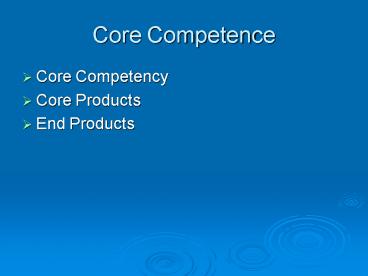Core Competence - PowerPoint PPT Presentation
1 / 17
Title: Core Competence
1
Core Competence
- Core Competency
- Core Products
- End Products
2
End Products
Core Products
Core Competencies
3
Clarify Core Competence
- Articulate a strategic Intent
- Identify Core Competencies
- How long could we dominate our business if we
didnt control this competency? - What future opportunities would be lost
- Does it provide access to multiple markets?
- Do customer benefits revolve around it?
4
Build Core Competencies
- Invest in needed technologies
- Infuse resources throughout BUs
- Forge strategic alliances
5
Coordinate diverse (production) skills and
integrate multiple streams of technologies
- Miniature electronics
- Miniaturization
- Microprocessor design
- Material science
- Ultra-thin precision casing
6
GTE vs. NEC -1980
- Active in telecommunications
- Positioned in display technologies
- Sales 9.98B
- Net cash flow 1.73B
- Comparable technological base
- No telecommunications experience
- Sales 3.8B
7
GTE vs. NEC -1988
- Sales 16.46B
- Telephone operating company
- Divested Sylvania TV and Telenet
- Closed down semi-conductors
- Moved other areas into joint ventures
- Sales 21.89B
- World leader in semi-conductors
- First tier player in telecommunications
- Included lifestyle products mobile phones, fax,
notebooks
8
NECs Strategy
- Exploit the convergence of computing and
communications CC - Communicated its intent to the whole organization
- Shifted resources to support components and
processors
9
Identified Three Interrelated Streamsof
Technological and Market Evolution
- Computing would evolve from Main Frame to
distributed processing - Components from ICs to VLSI
- Communications from mechanical to digital
- Semi-conductors would become the Core Product
10
GTE vs. NEC
- Portfolio of Competencies
Portfolio of Businesses
11
Growth 1980-1988
- Canon grew by 264
- Honda by 200
- Compare with Xerox and Chrysler
- Look at Honda and Canons Innovations
Note When Canon surpassed Xerox in world wide
unit market share in the copier market Its RD
budget was a small fraction of Xerox
12
The Problem with SBUs
Managers of one product line, or a group of
related product lines, generally look at the
products that are competing head on. They do
not look at, or try to untangle, the Web of
alliances there competitors may have built.
13
The real sources of advantage are to be found in
managements ability to consolidate corporate
technologies and production skills into
competencies that empower individual businesses
to adapt quickly to changing environments
14
Core Products
- Between core competencies and end products
- The linchpin between design and development
skills - The components or sub-assemblies that contribute
to the value of the end products
15
Core Products
- Many companies have a large, almost dominant
share of the core product market, even though its
name brand share is much less - Canon- 85 of the world market in laser printer
engines - Matshusita 45 world share in VCR components
- Matshisita 40 world share in compressors
16
Core Products
- To sustain leadership in their chosen core
competence areas companies seek to maximize their
world manufacturing share in core products - A dominant position in core products allows a
company to shape the evolution of applications
and end markets
17
Core Competencies at Canon































